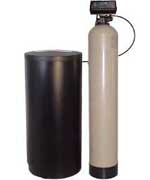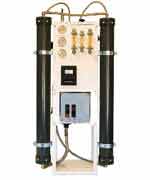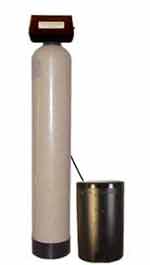There are many factors that may cause color in water. The most common causes are iron, manganese, tannins, organic matter, and/or colloidal solids that are too small and too fine to settle out properly.
These suspended particles can cause problems with disinfection processes, and also be an indicator of bacterial activity in the water. Turbidity is measured in NTU's, (nephelometric turbidity units). The turbidity of drinking water should always be less than 1 NTU. Most treated city water is less than .2 NTU.
If the color is from tannins or humic acids, then a self-cleaning automatic tannin filter might be applicable. These filters remove dissolved color by ion-exchange, using anion exchange media. The units we use regenerate with rock salt (sodium chloride). While these are called tannin filters, they are really ion-exchange units. Frequently we see shallow wells, or wells under the influence of surface run-off water, achieve high levels of tannins during heavy rainy periods. Tannin filters are often an excellent relatively low-cost technology to use for this type of problem, if the actual cause of the problem (such as sealing off the well from the surface) cannot be achieved.
Sometimes tannins are accompanied with iron or manganese. Water high in iron or manganese can sometimes be red, rust colored, brown, tan, black, or greenish in color. Chlorination or ozone, followed by a well designed iron filter can be very effective at removing tannin and these oxidized iron particles.
One method that we have successfully used to remove color in well water involves injecting a flocculant such as Cat-Floc-TL, which allows the microscopic suspended particles that create the color in water, to lose their positive charge and “floc” together into larger clumps. This is easily done on small scale systems by using a metering pump and injecting 2 -5 ppm of “Cat-Floc” (one of many types of flocculant aids used for this purpose) into the water as it flows into a holding tank or storage tank. The water is allowed to settle, and is followed by filtration to remove any suspended floc.
A very effective method to remove color is with reverse osmosis (“RO”) or ultrafiltration (“UF”) membrane systems. RO and UF systems can be used by homeowners, small communities and commercial sites to reduce turbidity and produce crystal clear water less than 0.1 NTUs. Care must be taken to properly pretreat the water if RO or UF is used if iron, manganese or hardness minerals are present.
In addition to RO and UF membrane systems, direct filtration can be used. Depending on the nature of the color, a backwashing sediment filter using a special type of zeolite filter media does a great job at clarifying water. Sediment down to the 5 to 10 micron range can be removed, and then backwashed out periodically by the automatic control valve.
Another low cost option is to use a whole house cartridge filter. These filters are large size filter cartridge systems which come in various micron ratings and can filter down to the 1 micron size. One option frequently used by homeowners with cloudy water is to use a backwashing sediment filter, followed by a 1 or 5 micron fitler cartridge system.
There are many different designs and application criteria that must be considered, including water chemistry, flow rates, how the water will be disinfected, and what types of filtration to use. In some cases additional treatment such as reverse osmosis or other types of membrane filtration, such as nano-filtration are used in place of or in conjunction with polymer injection and settling, for color removal.
Need help selecting a system? Fill out our quick and easy Water System Designer Form and get a response in 24 hours or less.









